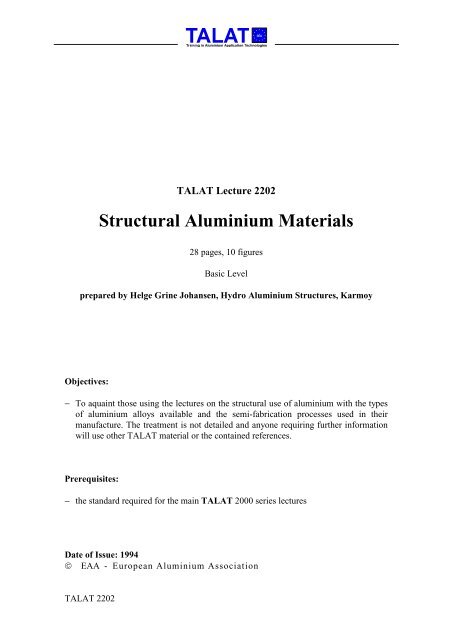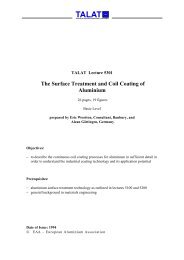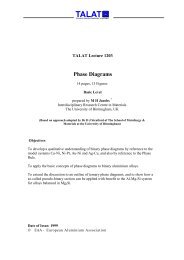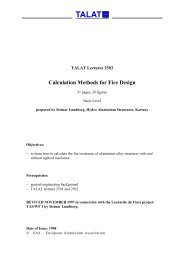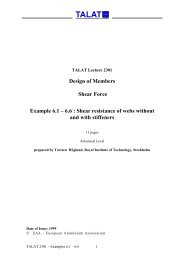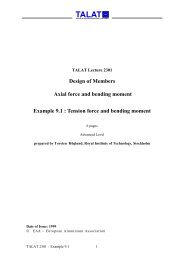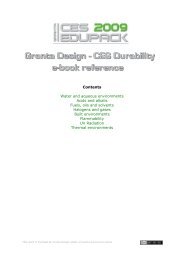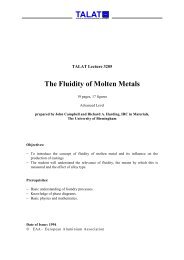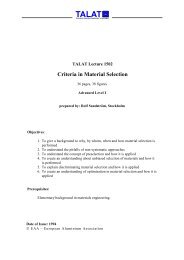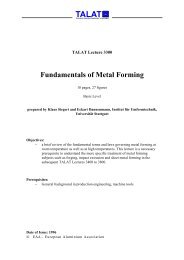TALAT Lecture 1302 - CORE-Materials
TALAT Lecture 1302 - CORE-Materials
TALAT Lecture 1302 - CORE-Materials
You also want an ePaper? Increase the reach of your titles
YUMPU automatically turns print PDFs into web optimized ePapers that Google loves.
<strong>TALAT</strong> 2202<br />
<strong>TALAT</strong> <strong>Lecture</strong> 2202<br />
Structural Aluminium <strong>Materials</strong><br />
28 pages, 10 figures<br />
Basic Level<br />
prepared by Helge Grine Johansen, Hydro Aluminium Structures, Karmoy<br />
Objectives:<br />
− To aquaint those using the lectures on the structural use of aluminium with the types<br />
of aluminium alloys available and the semi-fabrication processes used in their<br />
manufacture. The treatment is not detailed and anyone requiring further information<br />
will use other <strong>TALAT</strong> material or the contained references.<br />
Prerequisites:<br />
− the standard required for the main <strong>TALAT</strong> 2000 series lectures<br />
Date of Issue: 1994<br />
© EAA - European Aluminium Association
2202 Structural Aluminium <strong>Materials</strong><br />
Table of Contents<br />
2202 Structural Aluminium <strong>Materials</strong> ...............................................................2<br />
2202.01 Aluminium Alloys ..................................................................................... 3<br />
Aluminium and its Alloys........................................................................................3<br />
Pure Aluminium .................................................................................................. 3<br />
Aluminium Alloys: the main types....................................................................... 4<br />
Wrought alloys.................................................................................................... 5<br />
Casting alloys ..................................................................................................... 5<br />
The non-heat treatable alloys ............................................................................. 6<br />
The heat treatable alloys..................................................................................... 7<br />
The Alloy Designation System ................................................................................8<br />
The Four Digit Alloy Designation System .......................................................... 9<br />
Temper Designation.......................................................................................... 10<br />
The Choice of Alloy and Temper ..........................................................................12<br />
2202.02 Aluminium Product Forms ...................................................................... 13<br />
Extrusions for Structural Applications ..................................................................13<br />
The Extrusion Process ...................................................................................... 13<br />
Direct Extrusion................................................................................................ 14<br />
Indirect and Hydrostatic Extrusions................................................................. 14<br />
Extrusions for Various Applications................................................................. 15<br />
Sheet and Plate for Structural Applications...........................................................15<br />
The Cold Rolling Process ................................................................................. 15<br />
Hot Rolling........................................................................................................ 16<br />
Alloys for Rolled Products................................................................................ 17<br />
Casting Alloys for Structural Applications............................................................17<br />
Availability - Possibilities and Limitations............................................................18<br />
Extrusions ......................................................................................................... 18<br />
Rolled Products................................................................................................. 21<br />
Costs.......................................................................................................................23<br />
Rolled Products................................................................................................. 23<br />
Extruded profiles............................................................................................... 24<br />
Appendix: The nature of heat treatment ................................................................25<br />
Solution Treatment............................................................................................ 26<br />
2202.03 Literature/References ............................................................................... 27<br />
2202.04 List of Figures............................................................................................ 28<br />
<strong>TALAT</strong> 2202 2
2202.01 Aluminium Alloys<br />
• Aluminium and its alloys<br />
− Pure aluminium<br />
− Aluminium alloys: The main types<br />
− Wrought alloys<br />
− Cast alloys<br />
− The non-heat treatable alloys (non age-hardening)<br />
− The heat treatable alloys<br />
• The alloy designation system<br />
− The 4-digit system<br />
− Temper designation<br />
• The choice of alloy and temper<br />
Aluminium and its Alloys<br />
Pure Aluminium<br />
Pure, unalloyed aluminium, as produced at the primary production stage in electrolytic<br />
smelters, is cast into different shapes or forms suitable for manufacturing of semifinished<br />
products. Depending on the level of purity a distinction is made between<br />
− commercial purity (99,5 - 99,8% aluminium) and<br />
− high purity (up to 99,98% aluminium)<br />
The material is relatively soft with low mechanical properties; although the strength can<br />
be somewhat increased by forming processes, pure aluminium is normally not used for<br />
structural purposes. However, its corrosion resistance in normal atmosphere is excellent,<br />
its thermal and electrical conductivities are very high, and so is its formability. Pure,<br />
unalloyed aluminium is widely used for electrical, chemical, food packaging,<br />
petrochemical and building product applications.<br />
The mechanical properties can not be increased by heat treatment (age hardening), and<br />
pure aluminium is, therefore, classified in the group of non-heat treatable alloys.<br />
<strong>TALAT</strong> 2202 3
Aluminium Alloys: the main types<br />
Alloying elements added to pure aluminium improve its strength. Commonly used<br />
alloying elements are:<br />
copper (Cu)<br />
magnesium (Mg)<br />
zinc (Zn)<br />
silicon (Si)<br />
manganese (Mn)<br />
Other alloying elements like bismuth (Bi), boron (B), chromium (Cr), lithium (Li), iron<br />
(Fe), lead (Pb), nickel (Ni), titanium (Ti), zirconium (Zr), strontium (Sr) and sodium<br />
(Na) are added in small quantities to achieve special metallurgical effects or properties,<br />
e.g. grain refining, machinability etc.. Adding lithium (Li) in quantities of 3 to 5%<br />
improves the elastic modulus and decreases the density. Structural aluminium-lithium<br />
alloys are, however, restricted to aerospace applications, since special care and attention<br />
must be paid at the casting, fabrication, use and scrap recycling stages.<br />
Figure 2202.01.01 shows the principal alloying elements and the families of alloys<br />
derived from them.<br />
Al<br />
alu<br />
Training in Aluminium Application Technologies<br />
Principal Groups of Aluminium Alloys<br />
AlCuMg<br />
AlMgSi<br />
AlznMg<br />
AlZnMgCu<br />
AlSiCu<br />
AlSi<br />
AlMg<br />
AlMgMn<br />
AlMn<br />
Principal Groups of Aluminium Alloys<br />
<strong>TALAT</strong> 2202 4<br />
Cu<br />
Mg<br />
Zn<br />
Si<br />
Mn<br />
Heat Treatable<br />
Alloys.<br />
(Age Hardening)<br />
Non Heat<br />
Treatable Alloys.<br />
(Non Age Hardening)<br />
A further distinction is made between wrought alloys and casting alloys.<br />
2202.01.01
Wrought alloys<br />
Wrought alloys are designed specifically for fabrication by hot and cold forming<br />
processes, such as rolling, forging and extrusion. Magnesium and manganese are the<br />
principal aloying elements for non-heat treatable, wrought alloys. Magnesium is a very<br />
effective solid solution strengthening element, which is added up to 5% by weight.<br />
Chemical resistance is improved by adding magnesium, manganese or a combination of<br />
magnesium and silicon. If zinc, copper and/or silicon are added in addition to<br />
magnesium, very high strength alloys are obtained, which must be subjected to special<br />
heat treatments. The machinability is increased by adding lead and bismuth. High<br />
temperature strength properties are improved by additions of copper and/or nickel,<br />
manganese or iron. It is important to realize that alloying elements added to achieve<br />
improvements of specific properties may well reduce other important properties, eg.<br />
ductility, stress corrosion resistance, etc. In order to choose the best alloy for the<br />
particular use or working conditions, it is therefore important to be aware of all<br />
potentially detrimental working conditions. The choice of an alloy will often be a<br />
compromise with respect to best possible over-all performance.<br />
Casting alloys<br />
Casting alloys (or foundry allys) are exclusively used for the fabrication of cast parts<br />
and have favourable characteristics for this process. They exhibit high fluidity in the<br />
liquid state and good resistance to hot cracking during solidification. Castability is<br />
improved by the addition of silicon (7 to 13% Si). Increasing the silicon content further<br />
up to 25% reduces the thermal expansion down to levels of iron and steel. Such high<br />
silicon contents assure the dimensional stability upon heating e.g. for pistons in engines.<br />
The processing scheme in Figure 2202.01.02 gives a brief overview of the operational<br />
steps in the production of semi-finished products of wrought and casting alloys.<br />
<strong>TALAT</strong> 2202 5
Hot Rolling<br />
Cold Rolling<br />
Stretching<br />
Levelling<br />
Plate, Sheet<br />
Strip, Foil<br />
alu<br />
Training in Aluminium Application Technologies<br />
Processing Aluminium Alloys<br />
Holding<br />
Furnaces<br />
Casting<br />
Wrought Alloys Foundry Alloys<br />
Ingot Casting<br />
Billet Casting<br />
Extrusion<br />
Drawing Stretching<br />
Straightening<br />
Section, Rod<br />
Bar, Wire, Tube<br />
Primary Metal<br />
<strong>TALAT</strong> 2202 6<br />
Forging<br />
Free Form<br />
Forging<br />
Forgings<br />
Alloying Elements<br />
Mold Casting<br />
Sand Casting<br />
Die Casting<br />
Cast Parts<br />
Wrought Alloys Cast Alloys<br />
Processing Aluminium Alloys 2202.01.02<br />
For structural applications casting alloys play only a minor role when compared with<br />
wrought alloys. Because of the prevailance of wrought alloys in structural engineering<br />
applications they are described in some more detail below.<br />
Refering again to Figure 2202.01.01 the strengthening effect of alloying elements is<br />
caused by either solid solution strengthening or precipitation hardening or both.<br />
Depending on the prevailing type of strenghtening mechanism aluminium alloys are<br />
divided into two groups:<br />
The non-heat treatable alloys<br />
− Non heat treatable (Non-age hardening) alloys and<br />
− Heat treatable (Age hardening) alloys<br />
The non-heat treatable alloys (non age-hardening) are based on the following main<br />
element groups: see Figure 2202.01.01<br />
AlMg<br />
AlMn<br />
AlMgMn<br />
AlSiCu<br />
AlSi<br />
Strengthening is brought about by the combined effects of the alloying elements and<br />
work hardening (rolling, forging etc.). Depending on the degree of deformation work
hardening reduces ductility, which can be improved again by subsequent annealing<br />
(recovery and recrystallisation annealing). However, the concomitant reduction of<br />
strength properties cannot be reverted by renewed heat treatment - hence the term “nonheat<br />
treatable alloys“.<br />
The heat treatable alloys<br />
The heat treatable alloys (age-hardening alloys) constitute the following alloy groups:<br />
AlMgSi (6000 series)<br />
AlZnMg(Cu) (7000 series)<br />
AlCuMg (2000 series)<br />
AlLi (8000 series)<br />
These alloys obtain their strength by heat treatments. The mechanism of strengthening<br />
depends on finely distributed small particles in the crystal lattice of the grains, which<br />
reduce the motion of dislocations, ie. plastic deformation. The strengthening particles<br />
are precipitated from a supersaturated solid solution of alloying elements in the<br />
aluminium matrix and are coherent or partly coherent with the aluminium lattice. The<br />
constitutional requirements for heat treatable alloys are a substantial range of solid<br />
solubility of alloying elements at high temperatures and a very low solubility at lower<br />
temperatures as is e.g. exhibited by the phase diagram for binary Al-Mg2Si alloys in<br />
Figure 2202.01.03. To obtain a fine and even distribution of strengthening precipitates<br />
in the aluminium alloy matrix a heat treatment sequence has to be followed which<br />
consists of solution annealing at temperatures high enough to dissolve the alloying<br />
constituents (“α-phase“ region), of rapid cooling (“quenching“) to temperatures below<br />
290 °C or lower (supersaturation) and of ageing (precipitation) at room temperature<br />
(“natural ageing“) or at elevated temperatures in the range of 120° to 200°C (“artificial<br />
ageing“). This heat treatment sequence can be repeated several times - hence the term<br />
“heat treatable alloys“. See Appendix for further details on the subject of heat<br />
treatment.<br />
<strong>TALAT</strong> 2202 7
( o C)<br />
600<br />
500<br />
400<br />
alu<br />
Training in Aluminium Application Technologies<br />
- phase<br />
(Mg and Si in<br />
solid solution)<br />
The Alloy Designation System<br />
α<br />
+ liquid<br />
+ Mg 2Si<br />
1.0 2.0<br />
<strong>TALAT</strong> 2202 8<br />
The Heat Treatable Alloys<br />
α<br />
α<br />
liquid<br />
585 o C<br />
weight % Mg2Si<br />
Example of Phase Diagram for Mg 2Si in Aluminium 2202.01.03<br />
Worldwide, the national standards have been using different designation systems, and in<br />
addition many of the metal producers also use their own special alloy trade names.<br />
This multitude of standards and designation systems have confused many aluminium<br />
specifiers and designers and have led to misunderstandings and even to occasional<br />
product failures.<br />
However, the European countries and their respective aluminium manufacturers have<br />
now adopted the use of a common international designation and record system based on<br />
U.S. Aluminium Association (AA) standard.<br />
Alloy compositions and their designation system are contained in EN 573 Pt. 1-4 (1994)<br />
for wrought aluminium and aluminium alloys. The following description is based on<br />
this system.
The Four Digit Alloy Designation System<br />
A system of four-digit numerical designations is used to identify wrought aluminium<br />
and wrought aluminium alloys.<br />
♦ The first digit indicates the alloy group as follows:<br />
Al. 99,00 % purity and above 1xxx<br />
Copper (Cu) 2xxx<br />
Manganese (Mn) 3xxx<br />
Silicon (Si) 4xxx<br />
Magnesium (Mg) 5xxx<br />
Magnesium and Silicon (MgSi) 6xxx<br />
Zinc (Zn) 7xxx<br />
Other element (eg. Li, Fe) 8xxx<br />
Unused series 9xxx<br />
♦ The second digit indicates modifications of the original alloy or impurity<br />
limits.<br />
♦ The last two digits identify the aluminium alloy or indicate the aluminium<br />
purity.<br />
♦ A letter used as a prefix indicates an experimental alloy.<br />
♦ A letter used as a suffix indicates national variations.<br />
Some classification examples of commonly used alloys:<br />
Int. reg. record EN 573 ISO<br />
<strong>TALAT</strong> 2202 9<br />
1050A Al 99,5<br />
1070A Al 99,7<br />
2017A AlCu4MgSi<br />
3103 AlMn1<br />
5052 AlMg2,5<br />
5454 AlMg2,7Mn<br />
5083 AlMg4,5Mn<br />
6060 AlMgSi<br />
6063 AlMg0,5Si<br />
6082 AlSiMgMn<br />
7020 AlZn4,5Mg1
Temper Designation<br />
The temper designation system is based on a sequence of treatments used to produce the<br />
various tempers. Temper designations consist of letters followed by one or more digits.<br />
These digits designate specific treatments which influence the characteristics of the<br />
product. Basic temper designation:<br />
F as-fabricated<br />
Applies to as-fabricated products without special control over thermal conditions<br />
or strain hardening. For wrought products there are no guaranteed mechanical<br />
property limits.<br />
O annealed<br />
Applies to wrought products which are annealed to obtain the lowest strength<br />
temper, and to cast products which are annealed to improve ductility and<br />
dimensional stability.<br />
H strain hardened<br />
Applies to wrought products which have been cold worked with or without<br />
supplementary thermal treatments to produce some reduction in strength. The H is<br />
always followed by two or more digits.<br />
W solution heat treated<br />
An unstable temper applicable only to alloys which spontaneously age at room<br />
temperature after solution heat treatment.<br />
T thermally treated to produce stable tempers other than F, O, and H<br />
Applies to products which are thermally treated, with or without supplementary<br />
strain hardening, to produce stable tempers. The T is always followed by one or<br />
more digits.<br />
Subdivisions of basic tempers:<br />
The H-temper - strain hardened: The first digit indicates the specific combination<br />
of basic operations, as follows:<br />
H1 strain hardened only<br />
The number following this designation indicates the degree of strain<br />
hardening.<br />
H2 strain hardened and partially annealed<br />
Applies to products that are strain hardened more than the desired final<br />
amount and then reduced in strength to the desired level by partial<br />
annealing.<br />
H3 strain hardened and stabilized<br />
Applies to products which are strain hardened and whose mechanical<br />
properties are stabilized by a low temperature thermal treatment which<br />
results in slightly lower tensile strength and improved ductility. This<br />
designation is applicable only to those alloys which, unless stabilized,<br />
gradually age-soften at room temperature.<br />
The three-digit temper:<br />
<strong>TALAT</strong> 2202 10
The following three-digit H temper designation have been assigned for<br />
wrought products in all alloys:<br />
H111 Applies to products which are strain hardened less than<br />
the amount required for a controlled H11 temper.<br />
H112 Applies to products which acquire some temper from<br />
shaping processes not having special control over the amount of strain<br />
hardening or thermal treatment, but for which there are mechanical<br />
property limits.<br />
The following three-digit temper designations have been assigned for<br />
wrought products in alloys containing over a nominal 4% magnesium.<br />
H311 Applies to products which are strain hardened less than<br />
the amount required for a controlled H31 temper.<br />
H321 Applies to products which are strain-hardened less than<br />
the amount required fro a controlled H32 temper.<br />
H323/H343 Apply to products which are specially fabricated to have<br />
acceptable resistance to stress corrosion cracking.<br />
Subdivision of T temper - thermally treated<br />
Numerals 1 through 10 following the T indicate specific sequences of basic<br />
treatments. Some of the commonly used designations are:<br />
T4 solution heat treated and naturally aged to a substantially<br />
table condition. Applies to products which are not cold worked after<br />
solution heat treatment, or in which the effect of cold work in flattering or<br />
straightening may not be recognized as affecting mechanical property limits.<br />
T 5 cooled from an elevated temperature shaping process and<br />
then artificially aged. Applies to products which are not cold worked after<br />
cooling from an elevated temperature shaping process, or in which the effect<br />
of cold work in flattering or straightening may not be recognized in<br />
mechanical property limits.<br />
T6 solution heat treated and then artificially aged. Applies to<br />
products which are not cold worked after solution heat treatment, or in<br />
which the effect of cold work in flattering or straightening may not be<br />
recognized in mechanical property limits.<br />
The complete list of temper designations is given in the new European<br />
standards EN 515 (1993).<br />
<strong>TALAT</strong> 2202 11
The Choice of Alloy and Temper<br />
In addition to the general technological properties most suitable for the products’ actual<br />
working conditions, some other factors must also be considered before making the final<br />
alloy choice, such as<br />
− the available semi product range<br />
− delivery time from stock or plant<br />
− prices, etc.<br />
On the technical side, the end user will often find himself in a "give and take" situation.<br />
As an example, a special alloy with very high mechanical properties might be very<br />
sensitive to certain forms of corrosion, or can be difficult to weld. The availability on<br />
the market, minimum order quantities as well as product dimensions may also vary<br />
from one alloy to another. This will also be reflected in price.<br />
Tables of alloy properties can be found in applicable standards, handbooks and other<br />
publications, and they will give pointers to the most suitable alloys and tempers. The<br />
designer is well advised to consider the experience with alloys in similar or related<br />
applications. Reference is made to the alloy database ALUSELECT, which contains<br />
relevant alloy data and recommended uses.<br />
However, some individual alloys might have very special performance under certain<br />
working or environmental conditions, and it will always be useful to check with the<br />
producer if anticipated conditions and requirements are critical or if there is any<br />
uncertainty about the performance of the alloy in use.<br />
<strong>TALAT</strong> 2202 12
2202.02 Aluminium Product Forms<br />
• Extrusions for structural applications<br />
− The extrusion process<br />
− Direct extrusion<br />
− Indirect and hydrostatic extrusion<br />
− Extrusions for structural applications<br />
• Sheet and plate for structural applications<br />
− The cold rolling process<br />
− Hot rolling<br />
− Alloys for rolled products<br />
• Casting alloys for structural applications<br />
• Availability - possibilities and limitations<br />
− Extrusions<br />
− Rolled products<br />
• Costs<br />
− Rolled products<br />
− Extruded profiles<br />
Extrusions for Structural Applications<br />
The Extrusion Process<br />
In the extrusion process, a confined billet is forced by pressure to flow through an<br />
opening in a steel die forming the section shape of the extrusion. The shape may be of a<br />
simple or intricate form and the cross section may either be solid or hollow. With a<br />
suitable die design, aluminium extrusions can be produced in complicated shapes in a<br />
single step.<br />
Most commercial extrusion processes are carried out at temperatures in the range of<br />
400° - 500° C using a pre-heated billet. This most frequently used extrusion method is<br />
called ″Direct Extrusion″. Other methods in use are the ″Indirect and Hydrostatic<br />
Extrusions″. Round billets dominate in use, but sometimes rectangular billets are used<br />
to obtain extrusions with large widths.<br />
<strong>TALAT</strong> 2202 13
The most widely used extrusion alloys are the 6000-series (AlMgSi), and the extrusion<br />
speed for the 6063 alloy is between 20 and 70 m/min. Material with higher alloy content<br />
and/or complicated shape is extruded at a slower speed.<br />
Direct Extrusion<br />
In direct extrusion the billet is pre-heated and charged into the press container, and then<br />
the aluminium is pushed at a high pressure through a die to form either rod, bar, tube or<br />
other special shapes (Figure 2202.02.01).<br />
Indirect and Hydrostatic Extrusions<br />
These methods are based on the same principle as the direct extrusion method, and are<br />
normally used either for larger tonnages of special products (tube), or for the extrusion<br />
of special alloys etc.<br />
alu<br />
Training in Aluminium Application Technologies<br />
Hydraulic<br />
Cylinder<br />
Hydr. Aggregates<br />
Control<br />
Ram<br />
Ram<br />
Pressure<br />
Pad<br />
Billet<br />
Container<br />
Stem Billet<br />
The Direct Extrusion Press Arrangement<br />
<strong>TALAT</strong> 2202 14<br />
Billet Die Tools<br />
Billet Container<br />
Die<br />
Profile<br />
Profile<br />
Run-Out Table<br />
Hydr. Power / Control Extrusion Die Cooling and Run Out<br />
Back-Up Die<br />
2202.02.01
Extrusions for Various Applications<br />
Most aluminium alloys can be extruded, and the choice of the alloy is often based on<br />
special functional, metallurgical or fabricational factors.<br />
A few examples:<br />
High purity aluminium (the 1000-series) with very high electrical conductivity is used in<br />
extruded bus bars, cables or in other electrical equipment.<br />
AlMn (3000-series) alloys are used for drawn tubes due to very high formability and<br />
thereby also excellent dimensional tolerance abilities.<br />
High strength performance can be the reason why the 2000-series or the 7000 series<br />
alloys are chosen, although these alloys might have drawbacks such as poor or no<br />
weldability (Cu alloys) or potential danger of stress corrosion (Zn alloys).<br />
However, the majority of extrusions are made from the 6000-series alloys (AlMgSi)<br />
because of their good overall performance i.e.<br />
− relatively easy to extrude<br />
− medium to high strength in the T6 condition<br />
− good corrosion resistance in marine and industrial environments<br />
− good weldability by all welding methods<br />
− good availability on the market, both as standard and special sections<br />
In Europe, the main alloy used in extrusions for structural applications, is the 6082<br />
(AlMgSi1Mn), and the T6 is the normal used temper.<br />
Sheet and Plate for Structural Applications<br />
The Cold Rolling Process<br />
Sheet can be cold rolled directly from continuously cast and coiled re-roll stock, but the<br />
majority of sheet is produced by hot rolling of ingots followed by cold rolling. This<br />
process is often necessary in order to impart particular properties to the material.<br />
In some cases, cold rolling is carried out continuously on multiple stand mills (tandem<br />
rolling mill) (Figure 2202.02.02).<br />
<strong>TALAT</strong> 2202 15
COILER<br />
/ DE-COILER<br />
alu<br />
Training in Aluminium Application Technologies<br />
REVERSING COLD MILLS<br />
Multi Stand Reversing Cold Mill<br />
<strong>TALAT</strong> 2202 16<br />
COILER<br />
/ DE-COILER<br />
2202.02.02<br />
Alloys may be cold rolled to thicknesses of around 0,05 mm, and pure aluminium can be<br />
cold rolled to foil down to 0,006 mm. As the degree of cold working increases, the<br />
amount of power required for further deformation increases. Intermediate thermal<br />
treatments can then be necessary to soften the material for further cold rolling.<br />
Hot Rolling<br />
The starting material is normally a rectangular rolling ingot approximately 200 to 600<br />
mm thick, with a weight from 500 to 30 000 kg. Depending on the dimensions and alloy<br />
composition, the ingot is rolled to the final thickness in 10 to 25 passes (Figure<br />
2202.02.03).<br />
alu<br />
Training in Aluminium Application Technologies<br />
INGOT<br />
480 - 580 °C<br />
600 mm thickness<br />
REVERSING<br />
BREAKDOWN<br />
AND<br />
FINISHING<br />
MILL<br />
COILER<br />
280 - 350 °C<br />
5 - 8 mm thickness<br />
Single Stand Hot Mill 2202.02.03<br />
alu
Alloys for Rolled Products<br />
Although almost all wrought aluminium alloys can be fabricated into rolled semi<br />
products, the most frequently used rolled alloys for structural applications are:<br />
Non heat treatable alloys: 5052 (AlMg2.5)<br />
5083 (AlMg4.5Mn)<br />
5054 (AlMg2.7Mn)<br />
Heat treatable alloys: 6082 (AlMgSi1)<br />
7020 (AlZn4.5Mg1)<br />
Casting Alloys for Structural Applications<br />
The use of cast products for structural applications is mostly concentrated on engine and<br />
motor parts, automotive space frame nodes and bumper parts, aircraft components and<br />
components used in railway transport vehicles.<br />
The typical alloys for such products are AlSiMg, AlSiCu, AlMg, AlCuTi and AlZnMg,<br />
among which the AlSi-alloys are preferred with respect to castability.<br />
The main cast methods are: Sand casting<br />
Permanent mold (gravity) casting<br />
High-pressure die casting<br />
These methods usually require special variations of the different casting alloys for<br />
optimum casting performance.<br />
The definitions of products made by these methods are:<br />
Sand casting: produced by pouring molten metal into a sand mold and allowing it to<br />
solidify.<br />
Permanent mold casting: produced by feeding molten metal by force of gravity or low<br />
pressure into a mold constructed of durable material (iron or steel), and allowing it to<br />
solidify.<br />
Die casting: produced by injecting molten metal under high pressure into a metal mold<br />
or die and allowing it to solidify.<br />
The choice of method and alloy is very much dependent on the number of cast parts, the<br />
complexity of geometry and wall thicknesses, the material structure and strength and the<br />
product working conditions.<br />
<strong>TALAT</strong> 2202 17
Availability - Possibilities and Limitations<br />
Extrusions<br />
Although the extrusion process gives the designer a very wide range of profile shaping<br />
possibilities, it is also important to note that it does have limitations as far as shape,<br />
dimensions, maximum profile length etc.are concerned.<br />
Each extrusion press has its upper and lower limits on profile wall thicknesses, specific<br />
weight and outer circumscribing profile circle diameter (OD), and the tooling sizes and<br />
costs are usually also increasing with the increasing profile size amd complexity.<br />
It can sometimes seem advantageous to use the largest possible profiles in heavy<br />
constructions to save fabrication costs, but before any such decision is taken, it should<br />
always be a good rule to evaluate the alternative possibility of using profiles with<br />
smaller dimensions which are then joined together to form a larger section.<br />
The main cost parameters to be checked for both alternatives are:<br />
Fabrication costs (welding, handling, etc.)<br />
Die tooling costs<br />
Transport costs<br />
There are relatively few big extrusion presses available to produce profiles of the largest<br />
sizes, and delivery time from these plants should also be part of the calculation as<br />
should potential extra costs, such as keeping stocks of profiles for the case of unforeseen<br />
extra needs during the fabrication phase, and also for any need of spare parts.<br />
The designer should also be aware that while standard and special shape profiles might<br />
be available from the stockist, in general, the choice from stock is less extensive than<br />
that for standard steel products. However, to buy relatively small quantities of one type<br />
of profile directly from the extrusion plant can occasionally be expensive, due to the<br />
total overhead costs, and it can often be less costly to use the same profile dimensions to<br />
the largest possible extension in the construction, even if some of the structural<br />
members should be somewhat overdimensioned.<br />
When compared with a similar construction, in which minimum dimensional shapes are<br />
used, the weight saving might be reduced but the overall experience shows that there<br />
should be still a weight saving potential of 40 - 50 % and that the last and often marginal<br />
weight saving, might be very expensive.<br />
<strong>TALAT</strong> 2202 18
Figure 2202.02.04 describes the relationship between the size of the press, profile<br />
circumscribing circle, type of alloy and minimum wall thickness. It should be noted that<br />
each extrusion plant will have variations on these figures, and the table should only be<br />
used as a guideline.<br />
Lowest Wall Thickness Related to Press Capacity<br />
Alloy<br />
Al 99-99,9<br />
AlMgSi 0,5<br />
AlMn 1<br />
AlMg 1<br />
AlMgSi 1<br />
AlMg 3<br />
AlMg 5<br />
AlCuMg 1<br />
AlCuMg 2<br />
ALZnMgCu<br />
alu<br />
Training in Aluminium Application Technologies<br />
Min. possible wall thickness for extrusion presses 10 - 80 MN.<br />
Profile<br />
type<br />
Minimum Wall Thickness<br />
for Extrusion Presses 10-80 MN<br />
<strong>TALAT</strong> 2202 19<br />
a<br />
b<br />
c<br />
a<br />
b<br />
c<br />
a<br />
b<br />
a<br />
a<br />
0,8<br />
0,8<br />
1<br />
1<br />
1<br />
2<br />
1<br />
1<br />
1,2<br />
2<br />
25 50 75 100 150 200 250 300 350 400 450<br />
1<br />
1<br />
1<br />
1,2<br />
1,2<br />
1,5<br />
1<br />
1<br />
1,2<br />
2<br />
1,2<br />
1,2<br />
1,5<br />
1,2<br />
1,5<br />
2<br />
1,2<br />
1,2<br />
1,2<br />
2,5<br />
1,5<br />
1,5<br />
2<br />
1,5<br />
2<br />
2<br />
1,5<br />
1,5<br />
1,5<br />
3<br />
Press capacity (MN)<br />
10 25<br />
50 80<br />
35<br />
a: Solid / semi-hollow sections b: Hollow sections with equal wall thicknesses<br />
c: Hollow sections with unequal wall thicknesses<br />
2<br />
2<br />
2,5<br />
2<br />
2<br />
3<br />
2<br />
2<br />
2<br />
3<br />
2,5<br />
2,5<br />
2,5<br />
2,5<br />
2,5<br />
4<br />
2,5<br />
2,5<br />
3<br />
5<br />
2,5<br />
2,5<br />
2,5<br />
3<br />
3<br />
4<br />
3<br />
3<br />
5<br />
6<br />
3<br />
3<br />
4<br />
4<br />
4<br />
5<br />
4<br />
4<br />
5<br />
8<br />
4<br />
4<br />
5<br />
4<br />
4<br />
5<br />
4<br />
4<br />
6<br />
12<br />
4<br />
4<br />
5<br />
5<br />
5<br />
6<br />
5<br />
5<br />
7<br />
12<br />
5<br />
5<br />
6<br />
6<br />
6<br />
6<br />
6<br />
6<br />
8<br />
14<br />
2202.02.04<br />
Three basic profile types (Figure 2202.02.05) are defined which require different tool<br />
design: solid, semi-hollow and hollow profiles.<br />
If for any reason the fabricator finds it appropriate to build together two or more profiles<br />
to form a larger section, there are many possibilities for doing this. For structural<br />
members (Figure 2202.02.06), the normal joining method in such cases will be welding,<br />
but other methods or combinations of methods might also be appropriate, e.g. adhesive<br />
bonding.
Training in Aluminium Application Technologies<br />
A Solid:<br />
alu<br />
Three basic types of profiles<br />
B Semi-hollow:<br />
C Hollow:<br />
alu<br />
Training in Aluminium Application Technologies<br />
<strong>TALAT</strong> 2202 20<br />
The Three Basic Types of Extruded Cross Sections 2202.02.05<br />
Welded I-Beam Sections of Different Types<br />
A<br />
B<br />
A: Extruded profiles<br />
B: Fillet welds<br />
C: Extruded flat bar or rolled plate<br />
Welded I-Beam Sections of Different Types 2202.02.06<br />
General profile design principles: although almost any kind of profile geometry is<br />
possible, there are some basic issues that should be considered in order to reduce the<br />
chances of production problems, such as die tool breakages and dimension as well as<br />
tolerance problems. Figure 2202.02.07 gives some basic recommendations that always<br />
will lead to better production results.<br />
A<br />
C
alu<br />
Training in Aluminium Application Technologies<br />
Rolled Products<br />
Equal wall<br />
thickness<br />
Sharp edges<br />
Profile<br />
symmetrie<br />
Better dimensional<br />
control<br />
Avoid hollow<br />
sections if possible<br />
Increased strength<br />
of weak points<br />
<strong>TALAT</strong> 2202 21<br />
Insteads of this This is recommended<br />
Optimising Extruded Section Design<br />
2202.02.07<br />
There are some variations concerning the definitions of sheet and plate which are caused<br />
by traditions of the metric and other system. In most European countries it is common to<br />
call ″sheet″ flat-rolled products with thicknesses of less than 6 mm. Thicker flat-rolled<br />
material is called ″plate″.<br />
As mentioned above pure aluminium can be cold rolled down to foil of 0,005 mm<br />
thickness. Minimum rolled thickness of alloyed material is 0,05 mm. Most of the sheet<br />
and plate dimensions used in structural engineering lie in the thickness range of 1 to 150<br />
mm, with a majority in the range of 3 - 25 mm. The standard width and length<br />
dimensions of sheet and plate are 1000 x 2000 mm or 1250 x 2500 mm but both<br />
coldrolled and hot rolled materials can be produced as coil in different widths or plate<br />
with dimensions of 1500 x 3000 mm or even more. Available dimensions for sheet and<br />
plate vary from country to country. Manufacturers and stockists will supply relevant<br />
details.<br />
Sheet and Plate for Structural Applications:
It is normal to look to the highest tensile properties, but additional factors must be<br />
considered when choosing the optimal alloy and temper. The desired tensile strength<br />
should always be matched with requirements for<br />
Ductility<br />
Corrosion behaviour under the actual working conditions<br />
Weldability<br />
Fabrication requirements, such as cold forming (bending) etc.<br />
Thermal working conditions<br />
Some of the high-strength alloys might be sensitive to stress corrosion or intergranular<br />
corrosion under certain conditions, others can be difficult to weld. The general corrosion<br />
resistance in marine atmospheres may also be different from one alloy to another.<br />
Some alloys and tempers are also more available from market stock than others;<br />
depending on type and size of the construction, or quantity needed, this factor should<br />
also be considered together with price and delivery time.<br />
As a result of all this, a widely used alloy for structural applications is alloy 5052<br />
(AlMg2,5) in tempers from soft (H111) to medium hard as well as in stabilized<br />
condition (H32/H34).<br />
The tensile properties for this alloy are not the highest possible, but the corrosion<br />
resistance in most environments is very good and so is its weldability. There are no<br />
special restrictions with respect to bending or thermal working conditions. The availability<br />
on the market is very good.<br />
Another alloy increasingly used for structural applications is alloy 5083 (AlMg4,5Mn).<br />
This alloy has higher tensile properties than alloy 5052, but there are restrictions<br />
concerning the limits of continuous exposure temperatures (< 65 °C) and also with<br />
respect to cold forming requirements in fabrication (e.g. bending). The ready availability<br />
is generally somewhat less than for alloy 5052. Alloy 5083 has an excellent, high<br />
general corrosion resistance and very good weldability.<br />
Another important factor to be considered is the dependence of tensile properties on<br />
plate thickness for the 5000-series alloys. Alloys 5052 or 5083 are not available in<br />
work-hardened tempers beyond thicknesses of 100 mm. If higher strength is needed at<br />
larger thicknesses, it is necessary to change to heat treatable alloys such as 6082-T6. It<br />
has similar good general corrosion resistance and very good weldability.<br />
Some other alloys used as rolled products for structural applications are:<br />
2014 (AlCuSiMn)<br />
2017A (AlCuMg1)<br />
2024 (AlCuMg2)<br />
7020 (AlZn4,5Mg1)<br />
7075 (AlZnMgCu1,5)<br />
These are high strength alloys with either reduced or poor weldability and corrosion<br />
resistance and they are mostly used in special products or constructions, e.g. aircraft and<br />
military industries. Alloy 7020 is also used for general structural applications with<br />
<strong>TALAT</strong> 2202 22
equirements of high strength and good weldability, although its sensitivity to stress<br />
corrosion (in the short transverse direction) and to exfoliation corrosion in the heat<br />
affected zone of welds must be taken into account. Its particular advantage is the high<br />
strength of welded joints compared to all other weldable aluminium alloys.<br />
Costs<br />
Rolled Products<br />
Considering costs, it is necessary to evaluate the main relevant factors, such as<br />
− type of alloy<br />
− quantity and price<br />
− material dimensions<br />
− delivery time/eventual need for own internal stock<br />
− demands for special material control/certificates and traceability<br />
Type of Alloy<br />
Prices generally increase with the choice of alloy as follows:<br />
AlMn1 < AlMg2,5 < AlMg4,5Mn < AlMgSi1<br />
Quantity and Price<br />
Prices will naturally vary with ordered quantity both from stockists and from the rolling<br />
mill if delivered directly. The prices from the rolling mill will normally be somewhat<br />
lower, but it is usual to set a minimum production quantity, and the customer must<br />
accept eventual overdelivery up to a limit.<br />
Material Dimensions<br />
There will also be a variation in price related to the product dimensions. From stockist,<br />
standard products will always be both easier to find and also cheaper than products with<br />
special thicknesses, lengths and widths. The prices from the rolling mill will usually not<br />
be influenced by dimensions in the same degree. On the other hand, the product<br />
spectrum from stock might be limited depending on the geographic location in Europe.<br />
Delivery Time<br />
The delivery time from most stockists is short. It can, however, be influenced by<br />
transportation, handling time of customs paper work, etc. The delivery time from the<br />
rolling mill will naturally be longer, 10 to16 weeks being normal. In a situation like this,<br />
the end user might be in the situation where internal stock-keeping is necessary to secure<br />
his own production continuity. Such additional costs should also be considered.<br />
<strong>TALAT</strong> 2202 23
Demands for Special Material Control, Certificates and Traceability.<br />
These factors will normally mean additional costs and - except for standard material<br />
certificates - it is often difficult to get extra material control services when buying direct<br />
from stock. From some parts of Europe and the Far East it can even be difficult to get a<br />
standard certificate for the material. These issues are easier to handle when buying<br />
directly from the rolling mill, but the general understanding and requirements of modern<br />
industrial demands for quality assurance vary strongly from plant to plant.<br />
Extruded profiles<br />
There are numerous extrusion plants in Europe and each plant has its own limited<br />
product range, depending on sizes and number of the extrusion presses. Some plants<br />
have specialized on specific types of products such as drawn tubes, automotive parts<br />
etc., but most plants have a general market related production.<br />
The cost influencing factors are much the same as for rolled products, but some<br />
particular factors have to be considered when buying extrusions:<br />
Choice of alloy<br />
Die cost<br />
Profile size<br />
Delivery time<br />
The production plants’ quotes for supplying minimum delivery tonnage of each profile<br />
is normally considerably smaller than that from the rolling mills. This means that it is<br />
much easier to buy both standard and special profiles directly from a plant. For this<br />
reason, the stockist keeps mostly standard sections on stock and even then only in a<br />
limited range of sizes and alloys.<br />
Choice of Alloy<br />
If the selected alloy is a typical extrusion alloy, such as 6060 (AlMgSi0,5) or 6082<br />
(AlMgSi1), the basic material prices will have only small variations - if any at all.<br />
Die Costs<br />
The extrusion die costs are generally very low compared with die costs for casting<br />
moulds or for special punching or bending tools used in sheet forming. However, if a<br />
special extrusion die has to be made, costs will vary considerably with the profile size,<br />
type and complexity. The die costs for a hollow or semi-hollow section might be up to 5<br />
times more expensive than those for an open section, and the die costs for the largest<br />
profiles (350 - 600 mm OD ∗) ) can easily be twice or three times those for smaller<br />
profiles.<br />
Profile Size<br />
Not only the die costs are related to the profile size. Production factors also contribute to<br />
increase the price by 30 - 50 % for the largest profiles compared with profiles with OD<br />
less than 300 - 350 mm. Additionally, the minimum wall thickness for a large profile<br />
∗) OD: Outer circumscribing circle diameter<br />
<strong>TALAT</strong> 2202 24
will normally be higher than for smaller profiles. Those factors taken together indicate<br />
that it is sometimes necessary to compare the cost of a large profile made from a single,<br />
relatively expensive die with that of say two smaller sections made from cheaper dies<br />
and joined together - taking into account of course the additional fabrication costs.<br />
Delivery Time<br />
The delivery time for small or medium size profiles directly from the mill is relatively<br />
short (2 - 6 weeks), but for large profiles it might be considerably longer, 30 - 75 weeks<br />
are not uncommon. This time includes the extrusion die production.<br />
Appendix: The nature of heat treatment<br />
(Extraction from “Properties of Aluminium“ by Aluminium Federation, Birmingham,<br />
UK)<br />
An aluminium alloy is said to be in a heat-treated condition when it has been subjected<br />
to one or both of the following processes:<br />
a) Heating for a prescribed period at a prescribed temperature, then cooling rapidly from<br />
this temperature, usually by quenching (solution heat-treatment).<br />
b) Ageing, either spontaneously at ordinary temperatures (natural ageing) or by heating<br />
for a prescribed period at a prescribed low temperature (artificial ageing). The<br />
application of both solution heat-treatment and artificial ageing is often termed “full<br />
heat treatment“.<br />
The purpose of heat treatment is to increase the strength and hardness of an alloy.<br />
Solution heat treatment is an essential preliminary to artificial ageing, although an<br />
elevated temperature shaping process, such as casting or extrusion, can to some extent<br />
be used instead of normal solution treatment.<br />
Solution heat-treatment on its own initially increases the ductility of alloys and enables a<br />
certain amount of cold work to be applied before natural ageing starts to harden the<br />
metal. In its own right it increases strength but not to the level achieved by subsequent<br />
artificial ageing.<br />
While a metallurgical evaluation of the structural changes that take place in aluminium<br />
alloys during heat-treatment is beyond the scope of these notes, a simplified explanation<br />
might be useful.<br />
Effectively, heat-treatment is designed to alter the mode of occurence of the soluble<br />
alloying elements, particularly copper, magnesium, silicon and zinc, which can combine<br />
with one another to form intermetallic compounds. Solution heat-treatment takes these<br />
relatively hard constituents into solid solution, thereby softening the alloy: quenching<br />
retains the constituents in solid solution at room temperature, so that the alloy is still<br />
<strong>TALAT</strong> 2202 25
soft but unstable. The hard constituents gradually precipitate out in a more uniform<br />
pattern than they formed in the original un-heat-treated alloy, thereby improving the<br />
alloy’s mechanical properties. Rates of precipitation vary from alloy to alloy so that the<br />
stable condition represented by complete precipitation may take anything from a few<br />
days to several years to achieve unless artificial ageing is used. Even with alloys which<br />
achieve relatively stable properties by natural ageing it is possible to obtain higher<br />
strengths by artificial ageing following solution treatment. In some alloys an additional<br />
increase in strength is possible by controlled cold-working of the alloy immediately after<br />
quenching from the solution heat-treatment temperature. Because of the complex<br />
interactions that take place during the processes of heat-treatment, different alloys have<br />
different characteristics that require careful selection and control of the heating<br />
operations and specific combinations of temperature and time-at-temperature if the<br />
required properties are to be achieved in the heat-treated product.<br />
Solution Treatment<br />
Heating<br />
Maximum improvement in mechanical properties is attained when the solution heattreatment<br />
temperature is within the specified temperature range. If the temperature is too<br />
low, mechanical properties will be below requirements. If the temperature is too high<br />
there is a risk of cracking due to overheating. Heating periods cannot be given with the<br />
same accuracy as temperatures because of variations in the loading and spacing of the<br />
workload. The times should be determined by test and, when established, kept to. It is<br />
undesirable to solution heat-treat aluminium-clad alloy sheet for prolonged periods, or<br />
to re-solution treat clad material which has failed to achieve specification minimum<br />
requirements in terms of mechanical properties. This is because the alloying constituents<br />
tend to diffuse from the core into the aluminium cladding, thereby reducing resistance to<br />
corrosion. In general, cast aluminium alloys need to be solution heat-treated for longer<br />
periods than wrought aluminium alloys.<br />
Quenching<br />
Wrought aluminium is quenched by plunging the hot metal into water, but often such<br />
rapid cooling may distort the metal. With sheet, distortion can be minimised by vertical<br />
immersion and long sections or tubes should be quenched in the same way wherever<br />
possible. Plate, extrusions and strip may be discharged from a furnace horizontally and<br />
quenched by water sprays which are balanced to minimise distortion. Distortion can also<br />
be reduced by decreasing the cooling rate using hot water or oil as a quenching medium<br />
and this is often helpful with castings and forgings.<br />
Artificial Ageing<br />
Heat-treatable alloys such as 6082 harden very slowly at normal temperatures;<br />
hardening can, however, be accelerated by heating the solution heat-treated alloy in the<br />
<strong>TALAT</strong> 2202 26
ange 100 - 200 °C for a suitable period. The length of time at the specified temperature,<br />
depending on the alloy, can be as short as two hours or as long as thirty hours.<br />
Maximum strength is generally achieved by prolonged ageing at low temperature rather<br />
than by rapid ageing at high temperature.<br />
Re-heat Treatment<br />
Alloys which have been incorrectly heat-treated, for example by solution treating at a<br />
lower temperature than that recommended or by precipitation at too high a temperature<br />
for too long a period of time, can be re-solution treated and then precipitation treated<br />
again to enable optimum properties to be achieved. If, however, solution-treatment has<br />
been carried out at too high a temperature, the condition cannot be remedied by re-heat<br />
treatment. Clad material should not be re-heat treated.<br />
2202.03 Literature/References<br />
Aluminium-Taschenbuch<br />
Edited by Aluminium-Zentrale. XXVI/1094 pages, 699 figures, 342 tables,<br />
14.Edition, 1983/1988, ISBN 3-87017-169-3.<br />
Metals Handbook<br />
American Society for Metals, 2nd edition, Metals Park, Ohio, 1990<br />
E.Hatch (Editor): Aluminium - Properties and Physical Metallurgy<br />
American Society for Metals, Metals Park, Ohio, 1984, ISBN 0-87179-176-6<br />
ALUSELECT - The European Engineering Properity Database for Wrought<br />
Aluminium and Aluminium Alloys, 2 diskettes.EAA, KTH 1992<br />
D.G. Altenpohl: Aluminum Viewed From Within - An Introduction to the<br />
Metallurgy of Aluminum Fabrication, XII/225 pages, 190 figures, 16 tables.<br />
Aluminium-Verlag Düsseldorf, 1982, ISBN 3-87017-138-3<br />
The Properties of Aluminum and ist Alloys.<br />
Aluminum Federation Ltd., Birmingham 1993<br />
F. King: Aluminum and its Alloys.<br />
Ellis Harwood Series in Metals <strong>Materials</strong>. Ellis Harwood, Chichester, England<br />
1987<br />
<strong>TALAT</strong> 2202 27
Aluminum Association Inc.<br />
Registration Record of International Alloy Designations and Chemical<br />
Composition Limits for Wrought Aluminum and Wrought Aluminum<br />
Alloys. Aluminum Association, Washington DC, May 1987 (or most recent).<br />
2202.04 List of Figures<br />
Figure No. Figure Title (Overhead)<br />
2202.01.01 Principal Groups of Aluminium Alloys<br />
2202.01.02 Processing of Aluminium Alloys<br />
2202.01.03 Example of Phase Diagram for Mg2Si in Aluminium<br />
2202.02.01 The Direct Extrusion Press Arrangement<br />
2202.02.02 Multi Stand Reversing Cold Mill<br />
2202.02.03 Single Stand Hot Mill<br />
2202.02.04 Minimum Wall Thickness for Extrusion Presses 10-80 MN<br />
2202.02.05 The Three Basic Types of Extruded Cross Sections<br />
2202.02.06 Welded I-Beam Sections of Different Types<br />
2202.02.07 Optimizing Extruded Section Design<br />
<strong>TALAT</strong> 2202 28


